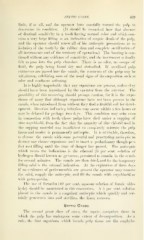Page 471 - My FlipBook
P. 471
SEPTIC CASES. 469
little, if at all, and the operator burs carefully toward the pulp to
determine its condition. (It should be remarked here that absence
of dentinal sensitivity in a tooth having normal color and which con-
tains a very large tilling is an indication of aseptic death of the pulp,
and the operator should renew all of his antiseptic precautions as to
isolation of the tooth by the rubber dam and complete sterilization of
all instruments and of the territory of operation.) The burring is con-
tinued without any evidence of sensitivity, and the instrument is finally
felt to pass into the pulj) chamber. There is no odor, no escape of
fluid, the pulp being found dry and shrivelled. If sterilized pulp
extractors are passed into the canals, the remnants of the pulp may be
withdrawn, exhibiting none of the usual signs of decomposition such as
odor and confluent softening.
It is highly improbable that any organisms are present, unless they
should have been introduced by the operator from the exterior. The
possibility of this occurring should prompt caution, for it is the expe-
rience of many that although organisms have not been present in the
canals, when introduced from without they find a fruitful soil for devel-
opment. Reaction indicating infection may occur within a few hours or
may be delayed for perhaps two days. This condition may arise even
in connection with teeth whose pulps have died under a capping of
zinc oxychlorid, from the fact that the quantity of zinc chlorid used in
the capping material was insufficient to completely saturate the pulp
tissue and render it permanently antiseptic. It is advisable, therefore,
to cleanse the canals with some powerful and penetrating antiseptic to
destroy any chance organisms and to insert a probationary though per-
fect root filling until the time of danger has passed. The antiseptic
which meets the indications is the ethereal 25 per cent, solution of
hydrogen dioxid known as pyrozone, ])ermitted to remain in the canals
for several minutes. The canals are then dried, and R)r the temporary
filling salol is the rational indication. At the expiration of three days
if no evidences of pericementitis are present the operator may renK)ve
the salol, reapply the antiseptic, and fill the canals with oxychlorid or
with gutta-percha.
The use of formalin (40 per cent, aqueous solution of formic alde-
hyde) should be mentioned in this connection. A 5 per cent, solution
placed in the canals is a coagulant antiseptic which quickly and cer-
tainly penetrates into and sterilizes the finest recesses.
Septic Cases.
The second great class of cases, the septic, comprises those in
which the pulp has undergone some extent of decomposition. As a
rule, the first organisms which invade pulp tissue are the staphylo-


